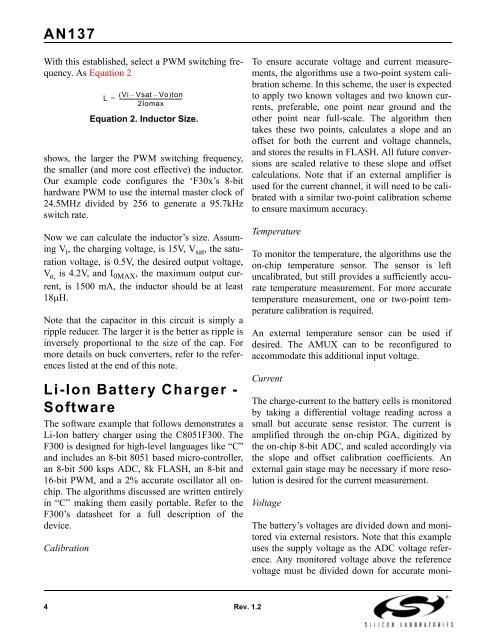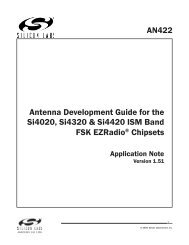LITHIUM ION BATTERY CHARGER USING C8051F300 Relevant ...
LITHIUM ION BATTERY CHARGER USING C8051F300 Relevant ...
LITHIUM ION BATTERY CHARGER USING C8051F300 Relevant ...
Create successful ePaper yourself
Turn your PDF publications into a flip-book with our unique Google optimized e-Paper software.
AN137<br />
With this established, select a PWM switching frequency.<br />
As Equation 2<br />
shows, the larger the PWM switching frequency,<br />
the smaller (and more cost effective) the inductor.<br />
Our example code configures the ‘F30x’s 8-bit<br />
hardware PWM to use the internal master clock of<br />
24.5MHz divided by 256 to generate a 95.7kHz<br />
switch rate.<br />
Now we can calculate the inductor’s size. Assuming<br />
V i , the charging voltage, is 15V, V sat , the saturation<br />
voltage, is 0.5V, the desired output voltage,<br />
V o, is 4.2V, and I 0MAX , the maximum output current,<br />
is 1500 mA, the inductor should be at least<br />
18µH.<br />
Note that the capacitor in this circuit is simply a<br />
ripple reducer. The larger it is the better as ripple is<br />
inversely proportional to the size of the cap. For<br />
more details on buck converters, refer to the references<br />
listed at the end of this note.<br />
Li-Ion Battery Charger -<br />
Software<br />
The software example that follows demonstrates a<br />
Li-Ion battery charger using the <strong>C8051F300</strong>. The<br />
F300 is designed for high-level languages like “C”<br />
and includes an 8-bit 8051 based micro-controller,<br />
an 8-bit 500 ksps ADC, 8k FLASH, an 8-bit and<br />
16-bit PWM, and a 2% accurate oscillator all onchip.<br />
The algorithms discussed are written entirely<br />
in “C” making them easily portable. Refer to the<br />
F300’s datasheet for a full description of the<br />
device.<br />
Calibration<br />
L =<br />
(<br />
---------------------------------------------------<br />
Vi – Vsat – Vo)ton<br />
2Iomax<br />
Equation 2. Inductor Size.<br />
4 Rev. 1.2<br />
To ensure accurate voltage and current measurements,<br />
the algorithms use a two-point system calibration<br />
scheme. In this scheme, the user is expected<br />
to apply two known voltages and two known currents,<br />
preferable, one point near ground and the<br />
other point near full-scale. The algorithm then<br />
takes these two points, calculates a slope and an<br />
offset for both the current and voltage channels,<br />
and stores the results in FLASH. All future conversions<br />
are scaled relative to these slope and offset<br />
calculations. Note that if an external amplifier is<br />
used for the current channel, it will need to be calibrated<br />
with a similar two-point calibration scheme<br />
to ensure maximum accuracy.<br />
Temperature<br />
To monitor the temperature, the algorithms use the<br />
on-chip temperature sensor. The sensor is left<br />
uncalibrated, but still provides a sufficiently accurate<br />
temperature measurement. For more accurate<br />
temperature measurement, one or two-point temperature<br />
calibration is required.<br />
An external temperature sensor can be used if<br />
desired. The AMUX can to be reconfigured to<br />
accommodate this additional input voltage.<br />
Current<br />
The charge-current to the battery cells is monitored<br />
by taking a differential voltage reading across a<br />
small but accurate sense resistor. The current is<br />
amplified through the on-chip PGA, digitized by<br />
the on-chip 8-bit ADC, and scaled accordingly via<br />
the slope and offset calibration coefficients. An<br />
external gain stage may be necessary if more resolution<br />
is desired for the current measurement.<br />
Voltage<br />
The battery’s voltages are divided down and monitored<br />
via external resistors. Note that this example<br />
uses the supply voltage as the ADC voltage reference.<br />
Any monitored voltage above the reference<br />
voltage must be divided down for accurate moni-



